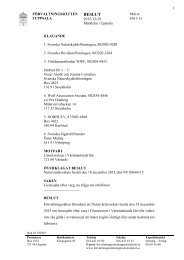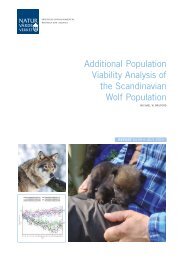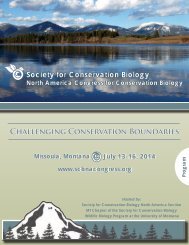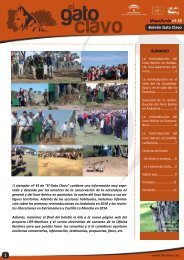1oC3Dbk
1oC3Dbk
1oC3Dbk
Create successful ePaper yourself
Turn your PDF publications into a flip-book with our unique Google optimized e-Paper software.
Giant Guitarfish (Rhynchobatus djiddensis). © Matt D. Potenski<br />
Trichechus senegalensis. © Tomas Diagne / Oceanium Dakar<br />
members to determine whether proposals meet the criteria<br />
for listing. Other SSG members were involved in the FAO ad<br />
hoc technical working group that reviews the proposals. The<br />
full IUCN/TRAFFIC analysis can be found here. Details of<br />
the FAO Assessment of the CITES Proposals are available<br />
here.<br />
Seven species of shark and ray were listed on CITES<br />
Appendices: Oceanic Whitetip Shark, three Hammerhead<br />
species, two Manta Rays, and with the uplisting of Pristis<br />
microdon, all sawfishes are now listed in Appendix I. With the<br />
EU Red List Office, the SSG began re-assessing all 143<br />
European sharks and rays. We published the North American<br />
regional Red List report which received considerable media<br />
uptake, particularly in North and South America.<br />
Nick Dulvy was invited to contribute to a Calgary Shark Fin<br />
Task Force, co-chaired by Aldermen Farrell and Pincott,<br />
including Shark Fin Free Calgary, the Calgary Zoo, and<br />
representatives from the community; with the goal of achieving<br />
meaningful civic action on the issue of shark finning. Both<br />
Chairs reviewed all Save Our Species applications for the<br />
“Sharks and Rays” call. Nick Dulvy won funds to undertake a<br />
scoping project to start developing a global Conservation<br />
Strategy for Manta and Devil Rays. A follow-on proposal was<br />
submitted to Save Our Seas Foundation. Colin Simpfendorfer<br />
won funds to develop national Shark and Ray report cards for<br />
Australia; this process will enable us to reassess the Australian<br />
and Oceania species. Simpfendorfer participated in a meeting<br />
of Pacific nations to build capacity to deal with sharks listed by<br />
CITES. This included training on the development of NDFs and<br />
cooperative arrangements between nations.<br />
The influence of the SSG continues to grow; we now have<br />
5,129 Facebook and 2,297 Twitter followers. Our work was<br />
made possible through the generous support of the Save Our<br />
Seas Foundation, the US State Department, the Fisheries<br />
Headquarters Program Office, US Department of Commerce<br />
and the Mohammed bin Zayed Foundation Species<br />
Conservation Fund.<br />
Nick Dulvy and Colin Simpfendorfer<br />
Co-chairs, Shark Specialist Group<br />
Sirenia Specialist Group<br />
The overarching goal of the Sirenia Specialist Group is to<br />
promote effective conservation of all four species of sirenians<br />
throughout their ranges, especially in developing range states.<br />
To lead the development of regional goals and objectives, the<br />
Sirenia Specialist Group has been re-organized into six<br />
regions; South American Regional Group, Meso-America<br />
Regional Group, United States Regional Group, West African<br />
Regional Group, Indian Ocean Region Members, Pacific<br />
Regional Group.<br />
The Specialist Group hosted the sixth International Sirenian<br />
Workshop at the 20th Biennial Meeting of the Society of<br />
Marine Mammalogy in Dunedin, New Zealand in December<br />
2013. The group newsletter Sirenews continues to be<br />
published bi-annually. In March 2013, CITES approved the<br />
transfer of the West African manatee from Appendix II to<br />
Appendix I. Experts from the Sirenia Specialist Group<br />
strengthened the final proposal. Twenty-five range states have<br />
now signed the UNEP/CMS Dugong MOU. Co-chair Helene<br />
Marsh attended the Second Signatory State Meeting (SS2) of<br />
the Memorandum of Understanding on the Conservation and<br />
Management of Dugongs and their Habitats throughout their<br />
Range in Manila, Philippines, in February 2013. The GEF<br />
Dugong and Seagrass Conservation Project Document has<br />
successfully undergone the UNEP Panel Review and is ready<br />
for submission to the GEF Secretariat for GEF review and<br />
endorsement.<br />
One of the goals of the Sirenia Specialist Group is to<br />
promote regional conservation actions of the Amazonian<br />
manatee. In August 2013, Co-chair Benjamin Morales visited<br />
the Centro de Rescate Amazónico (Rescue Amazonian<br />
Center) (ACOBIA-DWAZOO) in Iquitos, Peru, to learn of their<br />
Amazonian manatee recovery program and educational<br />
programs. This visit provided an opportunity to talk with the<br />
Centre Director Javier Velásquez, about developing regional<br />
strategies to improve the regional coordination between<br />
different institutions and NGOs, working on the conservation of<br />
the Amazonian manatee and its habitat along the Amazonian<br />
River. Morales also travelled to Puerto Narino in Colombia, to<br />
talk with Sarita Kendall at the Natütama Center and to learn<br />
about their educational programs. There was widespread<br />
enthusiasm for a regional workshop to encourage new<br />
collaborations between organizations. In November of 2013,<br />
Javier Velásquez and Juan Sánchez from ACOBIA and Fabia<br />
Luna from the National Center of Aquatic Mammal from Brazil<br />
came to Mexico to share their experiences in manatee<br />
conservation in captivity and reintroduction programs with<br />
Mexican experts.<br />
Specialist Groups, Task Forces and Red List Authorities<br />
81






